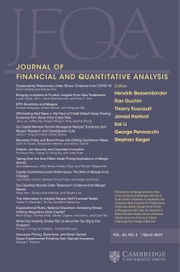Article contents
Cryptocurrency Pump-and-Dump Schemes
Published online by Cambridge University Press: 04 April 2025
Abstract
We document numerous occurrences of pump-and-dump schemes (P&Ds) targeting cryptocurrencies, which tend to trigger short-term episodes that feature dramatic increases in prices, volume, and volatility, followed by quick reversals. The evidence we document, including price run-ups before P&Ds start, suggests wealth transfers from outsiders to insiders. Our findings based on wallet-level data are consistent with the reasoning that gambling preferences, overconfidence, and naïve reinforcement learning help explain P&D participation. Finally, exploiting two natural experiments in which exchanges altered P&D policies, we find evidence consistent with the idea that P&Ds contribute to reduced cryptocurrency liquidity and lower prices.
Information
- Type
- Research Article
- Information
- Copyright
- © The Author(s), 2025. Published by Cambridge University Press on behalf of the Michael G. Foster School of Business, University of Washington
Footnotes
We thank Hendrik Bessembinder (the editor) and the two anonymous referees for their valuable feedback. We have benefited greatly from comments and suggestions made by Vikas Agarwal, Brad Barber, Natalie Cox, Nicholas Barberis, Kent Daniel, Itzhak Ben-David, Utpal Bhattacharya, Justin Birru, Patrick Bolton, David Brown, Markus Brunnermeier, Chris Burniske, Will Cong, Vyacheslav Fos, Simon Gervais, Kathleen Weiss Hanley, Campbell Harvey, Byoung Hwang, Jennifer Huang, Robert Jarrow, Wei Jiang, Lawrence Jin, Andrew Karolyi, Jiasun Li, Ye Li, Stefan Nagel, Andy Naranjo, David Ng, Mahendrarajah Nimalendran, Jun Pan, Jay Ritter, Harley Ryan, Harald Uhlig, Yizhou Xiao, Wei Xiong, David Yermack, Motohiro Yogo, Scott Yonker, and seminar participants at the U.S. Securities and Exchange Commission, the Cheung Kong Graduate School of Business, Cornell University, Fudan University (Fanhai), Korea University, Princeton University, Renmin University, the Shanghai Advanced Institute of Finance, the University of South Florida, the AEA, the LSE Paul Woolley Centre Conference, the CBER Conference, the Crypto Day Conference (Georgetown University), the GSU FinTech Conference, the University Blockchain Research Initiative Conference (UC Berkeley), the ABFER, the Annual Symposium in Financial Economics (ABFER, CEPR, and CUHK), the Chicago Financial Institutions Conference, the CICF, the China Fintech Research Conference (Tsinghua University), and the Toronto FinTech conference. We thank Yiming Chen, Blake Jackson, Chase Maxwell, Gunsu Son, Chuyi Sun, Sishun Wang, Zirui Wang, Wei Yang, and Jiawei Yu for their excellent research assistance. All errors are our own.
References
- 3
- Cited by

